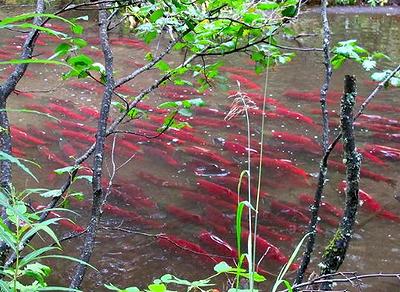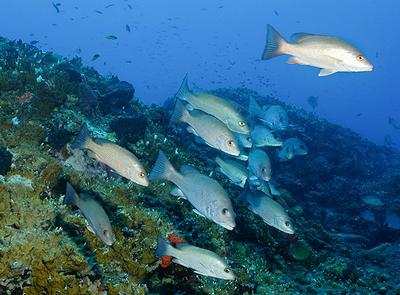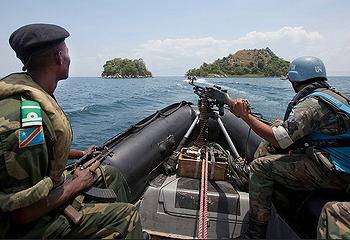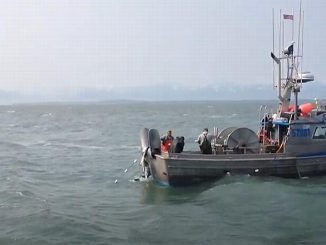
ANCHORAGE, Alaska, November 29, 2020 (ENS) – The U.S. Army Corps of Engineers has denied a permit to the proposed Pebble Mine, a giant copper and gold mine in Bristol Bay, Alaska that would threaten the world’s largest, most valuable wild salmon fishery. The decision met with approval from lawmakers on both sides of the aisle in Congress as well as environmental groups, but the mining company that proposed the project was “dismayed” by the decision.
Northern Dynasty Minerals Ltd. based in Vancouver, Canada, announced November 25 that its 100 percent-owned, US-based subsidiary Pebble Limited Partnership received formal notification from the U.S. Army Corps of Engineers that its application for permits under the Clean Water Act and other federal statutes has been denied.

The Corps found that Pebble’s “compensatory mitigation plan” as submitted earlier this month to be “non-compliant,” and that the massive mining project is “not in the public interest.”
Northern Dynasty called the decision “politically motivated” and said it is fundamentally unsupported by the administrative record as developed by the USACE through the Environmental Impact Statement, EIS, process for the Pebble Project.
The company confirmed that the Pebble Partnership will appeal the USACE permit denial within the 60-day window provided for appeal.
“For the United States to turn its back on an opportunity to develop these minerals here at home in a manner that US regulators have agreed is environmentally safe and responsible, and to do so for purely political reasons, is not just short-sighted,” said Northern Dynasty President and CEO Ron Thiessen. “It’s self-destructive.”
The company argues that the Final Environmental Impact Statement issued by the Army Corps in July, “found Pebble to be a project of merit that would fully co-exist with clean water, healthy fish and wildlife populations, and the important fisheries resources of southwest Alaska. The Final EIS also found that Pebble would make an important, positive socioeconomic contribution to the people and villages of Bristol Bay, Alaska – where full-time jobs are scarce and people face one of the highest costs of living in the country – as well as to the State of Alaska and the United States.”
But conservation groups are worried about damage to the great wild salmon fishery in nearby Bristol Bay, worth some $1.5 billion annually in the marketplace and immeasurably more to the lands and waters of southeast Alaska.
“The science is overwhelmingly clear. The proposed Pebble Mine is a catastrophe waiting to happen,” National Wildlife Federation President Collin O’Mara said in July after the Corps’ positive EIS was released.

All five species of Pacific salmon – sockeye, Chinook, coho, chum, and pink – spawn and grow in the Bristol Bay watershed, supporting wildlife like brown bears and eagles. The watershed supports the largest sockeye salmon run in the world, producing about 46 percent of the world’s wild sockeye harvest, says the World Wildlife Fund, and providing nearly 20,000 jobs throughout the United States annually.
Over 4,000 locals, including many native Yup’ik and Dena’ina, rely on fish, moose, and other subsistence foods for 80 percent of their protein.
“Pebble tried every trick in the book to push this project through, but the crystal clear science prevailed. Pebble would have devastating consequences for the world’s largest wild salmon fishery and all those that depend on it,” Earthworks Northwest Program Director Bonnie Gestring said. “Alaska’s Bristol Bay is no place for a massive mining operation.”
“The Biden administration should take the next step and use the Clean Water Act to place permanent limits on mining in Bristol Bay to protect the salmon fishery and the communities that depend on it,” Gestring urged.
The Secret Pebble Tapes
The permit denial follows an outcry against the mine this summer from people across the political spectrum and the release of the Pebble Tapes. Secret recordings of Pebble’s senior leaders, known as the “Pebble Tapes,” suggest that Congress, the Army Corps and the public may have been misled about Pebble’s planned scale and scope of the mine.
Pebble’s permit application limits the duration of the mine to 20 years, yet the private recordings show Pebble’s leaders believe it will operate for nearly 200 years and continually expand.
Chair of the House Committee on Transportation and Infrastructure Peter DeFazio of Oregon and Chair of the Subcommittee on Water Resources and Environment Grace Napolitano of California, both Democrats, sent letters to the Pebble Limited Partnership and the U.S. Army Corps of Engineers requesting records about the Pebble Mine tapes.
The letters asserted that statements made by top Pebble officials in candid recordings directly contradicted the information that was presented in both the permit to the Army Corps as well as in testimony by a former CEO of Pebble to the House Committee on Transportation and Infrastructure last year, acts that are misleading and possibly illegal, DeFazio and Napolitano wrote.
“From the private discussions revealed by the ‘Pebble Tapes,’ it seems as though Pebble was dealing with two sets of facts, one to lure potential investors to the Pebble project and one to alleviate fears of Alaskan Natives, the U.S. Congress and Federal agencies of potential adverse environmental impacts from the mine,” wrote DeFazio and Napolitano in their letters to Pebble Partnership CEO John Shively and U.S. Army Corps Lieutenant General Scott Spellmon.
“Pebble appears to have shuffled its deck of facts depending on the players at the table,” the Congressmembers wrote.

The mine site lies on a bench between two major Bristol Bay river drainages that together produce roughly one-quarter of the sockeye runs on a typical year. Although the mine covers a tiny fraction of Bristol Bay watersheds, salmon advocates fear a failure of any dams holding mine waste could devastate much larger stretches of the fishery.
Mine critics point to decades of research that have found Bristol Bay’s productivity is linked to a landscape of many different spawning streams. In a typical year, roughly 40 million salmon turn vast stretches of waterways red as they return from the ocean to spawn in the streams and lakes where they were hatched.
The Corps’ EIS says the mine would damage 160 kilometers of fish habitat and 18 square kilometers of streams and wetlands. Yet, in a landscape laced with rivers draining an area the size of Virginia, the Corps concluded the mine “would not be expected to measurably affect the health or value” of the lucrative Bristol Bay salmon fishery.
In 2014, under President Barack Obama, the Pebble Mine project appeared dead after the U.S. Environmental Protection Agency said it would not issue federal permits to fill wetlands, concluding the mine posed too great a threat to the environment. But after President Donald Trump came to office, EPA withdrew this finding and re-evaluation proceeded.
Even so, the Corps’ Record of Decision issued November 25 found the massive mine not to be in the public interest.
Among those who are pleased that the great Bristol Bay salmon run will be protected from mining runoff and other development are DeFazio and Napolitano.
DeFazio said, “With this decision, the U.S. Army Corps of Engineers has made it clear that a foreign mining company with highly dubious business plans cannot be allowed to damage an irreplaceable habitat and the ancestral home of many Alaskan Natives.”
“Our work on Pebble Mine has shown that the negative impacts of constructing this project will last forever, permanently altering the economic, environmental, and cultural importance of this region,” said Napolitano. “Today’s decision affirms that protecting the last remaining salmon habitat and the ancestral home of many Alaskan Natives cannot be bought. I commend the Corps for moving us forward.”
U.S. Senators Lisa Murkowski and Dan Sullivan, both Alaska Republicans, are advocates of mining in Alaska, but they both oppose the Pebble Mine project and voiced their strong support for the Army Corps’ decision to deny the permit.
“After years of review and analysis, the Army Corps has found that this project is ‘contrary to the public interest,’ ending consideration of its permit application and affirming that this is the wrong mine in the wrong place,” Murkowski said.
“This is the right decision, reached the right way. It should validate our trust and faith in the well-established permitting process used to advance resource development projects throughout Alaska. It will help ensure the continued protection of an irreplaceable resource – Bristol Bay’s world-class salmon fishery – and I hope it also marks the start of a more collaborative effort within the state to develop a sustainable vision for the region.”
“I welcome the Army Corps’ Record of Decision to deny the permit,” said Senator Sullivan. “Given the special nature of the Bristol Bay watershed and the fisheries and subsistence resources downstream, Pebble had to meet a high bar so that we do not trade one resource for another. As I have been saying since August, Pebble did not meet that bar and, accordingly, the Corps rightly denied the permit.”
The Mine That Was Denied
The Pebble Limited Partnership proposed to develop the Pebble copper-gold-molybdenum porphyry deposit as an open-pit mine, with associated infrastructure, in southwest Alaska, 17 miles west-northwest of the villages of Iliamna, Newhalen, and Nondalton. The proposed mine required many federal, state, and local permits.
The Pebble Project was located in a sparsely populated region of southwest Alaska near Iliamna Lake. The project consisted of four primary elements: the mine site, the Diamond Point Port, the transportation corridor including concentrate and water return pipelines, and the natural gas pipeline and fiber optic cable.
The deposit is located under rolling, permafrost-free terrain, 200 miles southwest of Anchorage and 60 miles west of Cook Inlet. The mine site is not currently served by roads or railroads, nor is there a connection to existing utility infrastructure. The only access is by helicopter or by snow machine during winter.
The project was proposed as a conventional drill, blast, truck, and shovel operation with a mining rate of up to 73 million tons per year. Some 1,300 million tons of mineralized rock and 150 million tons of waste rock would have been mined over the life of the project to produce 613,000 tons of copper-gold concentrate and 15,000 tons of molybdenum concentrate each year.
The purpose of a natural gas pipeline from the Kenai Peninsula would have been to provide a long-term stable supply of natural gas to meet the energy needs of the project by connecting to the existing regional gas supply network.
Although the project design presented by the Pebble Limited Partnership in this application includes numerous measures to avoid and minimize impacts to wetlands and other values such as air quality, wildlife and aquatic habitat, areas of cultural significance, and areas of known subsistence use, the Corps still saw fit to deny the permits.
Pebble Partnership CEO John Shively said, “We are obviously dismayed by today’s news given that the USACE had published an Environmental Impact Statement in July that clearly stated the project could successfully co-exist with the fishery and would have provided substantial economic benefit to the communities closest to the deposit. One of the real tragedies of this decision is the loss of economic opportunities for people living in the area. The EIS clearly describes those benefits, and now a politically driven decision has taken away the hope that many had for a better life. This is also a lost opportunity for the state’s future economy – especially at a time when Alaska is seeing record job losses from the impacts associated with Covid.”
But Guido Rahr, CEO of the nonprofit Wild Salmon Center, said, “Today, we thank the Army Corps for doing the right thing. The agency recognized what Bristol Bay Tribes, fishermen, independent scientists and the EPA have long established: Pebble Mine is too destructive for the Bristol Bay ecosystem. Today’s decision gives the people of Bristol Bay temporary relief from this mine. It’s now time for EPA to use the Clean Water Act to kill this mine once and for all.”
Copyright Environment News Service (ENS) 2020. All rights reserved.



